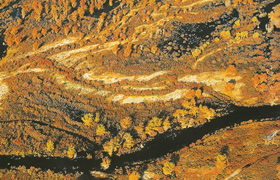
Tarim River, which was called Shushui or Conglinghe in the ancient Chinese records, flows in the northern part of Tarim Basin. It was about 1000 kilometers in its prime, and the length of the river would be 2179 kilometers f the length of its major branch. Yarkent River, is put into account. So it is the longest inland river of China and the drainage area is about 198,000 square kilometers. In the long past, most of the rivers of Tarim Basin flew into Tarim River, which made great contribution to the formation of the civilization of ancient Xinjiang. And it is because of this that Tarim River has been called “mother river” of the region.
In the past years, due to the development of local industry and agriculture, which in turn has brought about changes in the nature and human society, the river ends at Daxihazi Reservoir near to Tielkhelik with the water only from three branches, Aksu River starting from Tianshan Mountain, Yarkent River and Hotan River starting from Kunlun Mountains and the water is less and less from the upper parts to the downs parts.
The river's alluvial valley is very large with fertile soil and luxurious vegetation, so it is suitable for the developing farming. And the river itself often changed its sheds and ran wild, so the river valley is like the maze. The central government has paid great attention to eco-environmental changes of Tarim River, including the cutout of the river water and many measures, including leading the water to the down valley and restoring the vegetation of the bank area, have been taken to improve the environment.



